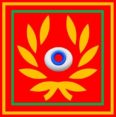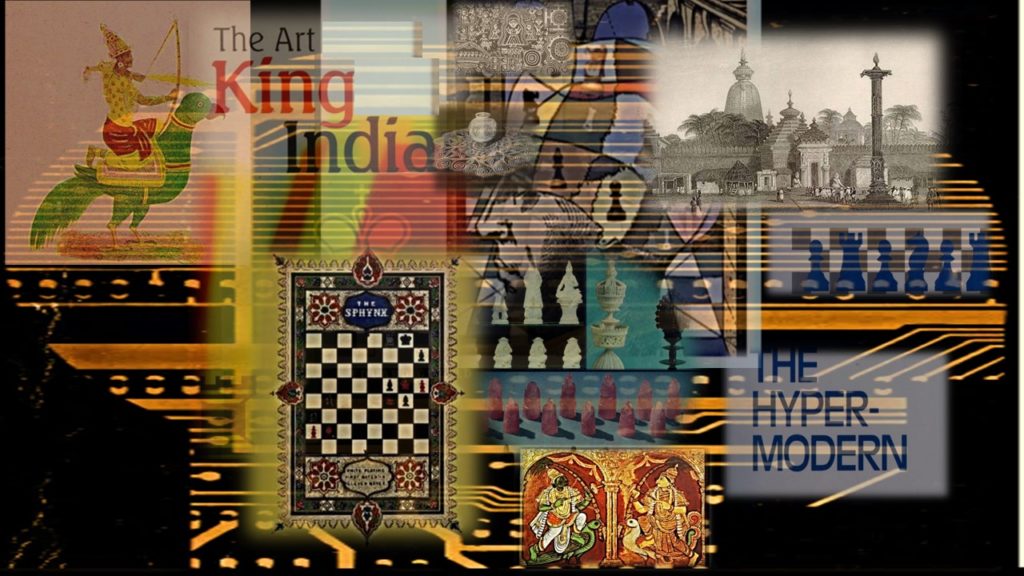Lets get some related wider context at this point. It is a tradition within India to have its scriptures containing verses with exactly 32 syllables each. These are called catuh-slokas, fourfold slokas (verse), consisting of four lines each with eight in. Four rows of eight. In chess each player has two rows of 8 pieces and the space between them is four rows of 8 also. So Indian scripture parallels the array we see in chess. In South India there are games played called Aksharaslokam which have someone speak the first two sets of 8, 16, of a 32 syllable shloka or verse, and then someone else will carry on after with the other 2 sets of 8. Again just like in chess, two people each bouncing back and forth to each other in reply in turns with the same numbers. They naturally and symmetrically fit together, chess play and scripture quotes, each in their own ways, same skeletal structure. The Bhagavad Gita, a great scripture of the Krishna tradition has this 32 syllable verse structure, as do many of the others, and this pattern is found in other traditions besides those of Krishna. It was a common occurrence from Vedic times of old and how far back it goes one does not know. There was even a poetic technique of placing letters on a chessboard, more specifically, using a chess knight on half a chessboard of four rows of eight with letters on, to touch each square so that it covers each square once, known as a ‘knights tour’ and thus creating the sequencing of the letters so that lines of poetry emerged. Hence chess itself was used to generate poems! Literary traditions of Kerala concerning its warriors ballads such as Vadakkan Pattukal contain chess allegories within them. Land in Kerala was sometimes decided in quarrels over a chess game deciding the ownership! Added to all this we have the Vastu Purusha mandalas and patterns, the sciences of Indian temple architecture where one can easily see 8×8 or 64 square patterns upon which foundations temples are designed. We also see that there are also circular 64 spoke wheel temples too, with a semi animal/bird goddess Yogini on each spoke and such Yogini traditions largely remain a mystery and can only be partially reconstructed and they are also alchemical, a subject I shall refer to here and there as I go along and as we shall see elsewhere there eventually exists what is called Rosicrucian Chess, or Enochian Chess within the latter day alchemical European continuum. In Indian traditions we also 8×8 squares painted on palm leaf and other such materials, the traditions of yantra and mandala, each square associated with an aspect of the goddesses. If ever there is a rich symbolism to be read into chess games, we must not forget Indian spiritual traditions side by side, and see chess and them as simultaneously one and different! These points are not often pointed in chess history even still in modern times.
So the Krishna-Chaitanya tradition uses chess numbers and in the context of the above shouldn’t be surprising that very important and central themes in the tradition gather around the chess numbers, which we shall look at in some detail. In the case here it is the association not just with chess and its number structure but also with love Cupid-Kama. It may not be an exaggeration to claim the Krishna tradition as the richest in the Cupid/Kamadeva continuum. In the west, the chess number structure, more directly via chess itself as a symbol, associates with love, sometimes divine, sometimes of courtly society. The demigod associated with this board of love has been in Conty’s text, Cupid, and by being associated with chess, is also in lieu of that associated with the number and structure of the board and pieces, with 8, 16, 32 and 64 too. Kamadeva, the Cupid of India, especially in Jagannatha Puri, associates rather with the numbers in chess, rather than anything directly concerning boards, pieces. There is a Sanskrit text called the Sataranja where in one version, Radha and Krishna narrate this Sanskrit text which explains the origin and development of chess. I have not be able to find anything about it, or any reference to it online. It is quoted in a book by Victor A Keats’ Chess In Jewish History and Hebrew Literature. He further mentions that this Sataranja is rare. That the Sataranja has a version set in the context of a conversation between Radha and Krishna is found in Keats’ work where he quotes part of a preface to an edition of it, by Chintaharan Chakravarti. This edition and its preface part quoted by Keats details is mentioned as being from Krishnagar College, March 1946. Thats all that is mentioned as to it. Also in the footnote he mentions there are four manuscripts of the Sataranja in the Royal Asiatic Society of Bengal’s library and that the preface writer just mentioned also writes of the known Sataranja’s in the Indian Historical Quarterly, 14 (1938) on pages 75-9. There is art work showing the Divine Love Couple in a flowered pavilion playing chess together and other art shows them playing other games. In later Gaudiya Vaishnava tradition and there is mention of chess directly with the Divine Lila of Krishna too and I shall detail this in another post. There is also a reference in early Chaitanya tradition to Chaitanya playing chess with an associated Gadadhar in the garden of the Tota Gopinath Temple near to the Jagannatha temple in Orissa and this is considered a divine pastime which involves a festival of throwing flowers at each other.
In the Les Eschez d’Amours there are 32 tokens of love, a chess heraldry so to speak, which stands parallel and akin to all of this, something most sublime indeed as we shall see more of in details.
One of the various mantras used for worshiping Vishnu, is mentioned in the Saradatilaka, which too is full of chess number dealing with other such things as Shiva and other main deities. This text is one of authorities concerning the Jagannatha temple worship. This Vishnu mantra is composed of 8 letters. Vishnu is described therein as being colored like the lightning and the moon, half of his body in the spiritual realm Vaikuntha and the other half in the Kamalaja. Kamalaja is also another name for the Goddess Lakshmi, Vishnu’s wife elsewhere. Thus we see Kama tied up with Vishnu, an indication of the realm of Kama, and perhaps an indication of the feminine source of Kamadev, as in some accounts Kamadeva being Pradyumna, the son of Rukmini, Krishna’s chief wife of his kingdom (who represents a level or plane of highest Goddess next up on the level from Lakshmi-Kamalaja in some of the traditions, in other traditions Rukmini is an extended aspect of the Lakshmi plane of spiritual consciousness form). Abode is also effulgence forms of deity aspect too and vice versa. Hence in one way, this would be like saying Kamalaja contains Kama, which in turn being an aspect of Vishnu, is part of the chief energies over this actual material dimension-earth and is tied up with part of the other half of the body of God of the spiritual and other realm. Its a position that’s usually higher than Kamadeva elsewhere and a formless aspect too, an abode, the Kamalaja, which is fitting as Kamadeva was turned formless by the force of Shiva’s third eye when he disturbed Shiva’s meditation in order to get Shiva to come out of his meditation to mate with his spouse Uma-Parvati to give birth to a son to destroy a great demon who was tyrannizing the universe. This old link of Vishnu to Kama is an aspect of the Kamadeva tradition in its own way which is not commonly known, and is not an important part particularly of the Saradatilaka text either, but if we reflect a little deeply on its implications and possibility of interpretation according to later Vaishnava theologies, it is something interesting. There are more direct Kamdev parts in the Saradatilaka as we shall see.
Krishna is associated with Vishnu too, usually as Vishnu’s best qualities personified, other times Vishnu in his truest and highest form, beyond his regal nature as the rustic nature of Krishna is more intimate. Whatever the case may be it would seem that Kamadeva and his realm is here somewhat associated with Vishnu. And Vishnu here has eight arms, one with a special gesture of hand signal, one a lotus, one a mirror, another a jar of gems, another a lotus, in another a mace, another a conchshell, then a disc, or chakra wheel, in the other.
Also the love theme is there too, as in the Saradatilaka, it is mentioned also how there is a beautiful garden wherein is Purusottama Vishnu, with his consort who is embracing him with a lotus in her left hand and her right arm embracing the smiling Puritanism who has also eight arms this time holding the conchshell, noose, hammer, bow, arrow, sword, mace and goad in each. Krishna is Purusottama, Purusottama is Jagannatha, and is also Vishnu, they all tie up together and as we have seen with Kamalaja as some earthly half in the service of spirit realm which presumably in lieu of being directly tied to Vishnu is nevertheless the highest earthly so to speak. Also in the Saradatilaka there is mention of the 32 letter Krishna mantra for deity worship, as well as a 16 one, also an 8 syllable one too. We shall shortly look at this in much more detail, it is of import to Kamadeva directly and the Krishna traditions associated with the Golden Purusha Chaitanya.

